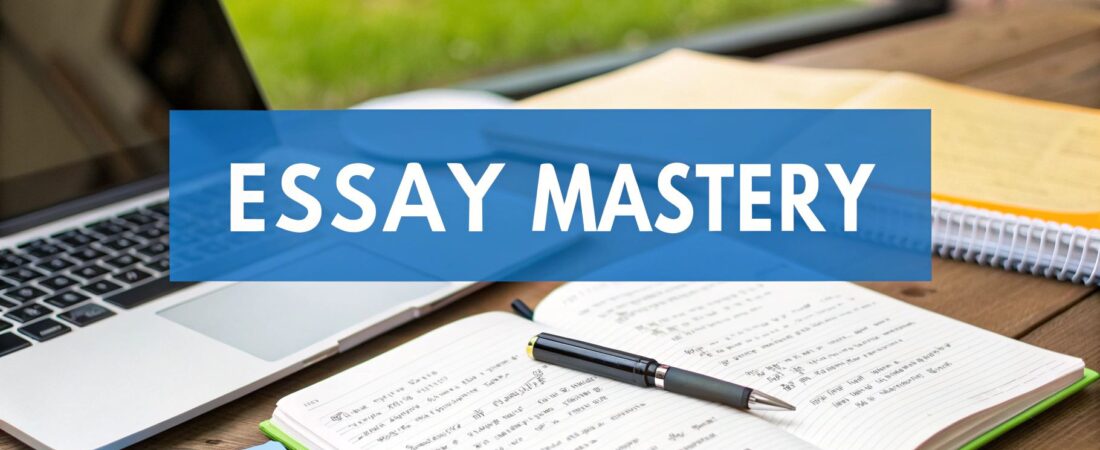Breaking Down the Elements of Exceptional Essays

Creating an outstanding essay requires mastering multiple key components. By understanding and implementing essential elements of structure, argumentation, and style, you can elevate your writing from basic to exceptional. Let's examine each of these components in detail to help improve your essay writing skills.
Structure: The Foundation of a Strong Essay
Like architecture, essay writing depends on a solid foundation. A well-structured essay gives your ideas room to develop naturally while keeping readers engaged. Start with an attention-grabbing introduction that presents your thesis statement clearly. Follow this with body paragraphs that each explore one main idea, supported by relevant evidence and analysis. End with a conclusion that reinforces your key points and leaves readers with something to consider. Recent research from the International Journal of Social Science shows that even students with good writing abilities often struggle with organization, highlighting why careful planning and outlining are so important before drafting begins.
Argumentation: The Heart of Persuasion
A strong framework needs equally strong content. Effective argumentation requires more than stating opinions – it demands building a logical case supported by evidence. Begin with a focused thesis that directly addresses the essay prompt. Then back up your points with specific examples and data. For instance, if writing about social media's effects on mental health, include research studies showing connections between platform use and anxiety levels. But don't just list facts – analyze how your evidence supports your thesis and what it means in the larger context. This analysis demonstrates critical thinking and helps readers follow your reasoning.
Style and Clarity: Engaging Your Reader
While solid structure and arguments form your essay's core, engaging style and clear writing make it compelling to read. Consider two essays making identical points – one written in dense, confusing language versus one that flows smoothly with clear explanations. The accessible version will be far more effective at conveying ideas. Focus on using precise words, avoiding unnecessary jargon, and constructing logical sentence progressions. Mix up sentence patterns and add smooth transitions between ideas to maintain reader interest. The goal is both informing and engaging your audience. Writing experts at The Atlantic Monthly emphasize that developing an effective style takes consistent practice, but mastering clarity and flow is essential for strong essay writing.
By focusing on structure, argumentation, and style working together, you can significantly strengthen your essays. These elements complement each other to create clear, persuasive writing. As you develop these core skills through practice, you'll find yourself better able to express complex ideas effectively in your academic work.
Crafting Arguments That Actually Convince

Once you have mastered essay structure and writing style, the next key skill is developing strong arguments that truly persuade your readers. Instead of simply listing points to support your thesis, you need to build logical reasoning that guides readers to accept your perspective. Let's explore practical techniques for creating arguments that resonate and strengthen your essays.
Framing Your Argument: Beyond the Basic Thesis
While a clear thesis sets your direction, creating a strong argument requires much more. Think of your essay like constructing a building – the thesis provides the foundation, but you need a sturdy framework to support everything else. One useful approach is the Toulmin model, which breaks arguments into key components: claims, evidence, warrants, backing, qualifiers, and rebuttals. For example, if you claim that social media increases teenage anxiety, you would include evidence like screen time and anxiety statistics. You would then explain the connection between this evidence and your claim by referencing research on social media's psychological effects.
Incorporating Evidence and Analysis: Showing, Not Just Telling
Strong arguments need solid evidence like statistics, research findings, expert opinions, and real examples. But simply listing facts isn't enough – you must explain how each piece of evidence supports your main point. For instance, rather than just stating "57% of teenagers feel anxious after using social media," dig deeper into what this statistic reveals about the relationship between social media use and mental health. This analytical approach shows critical thinking and helps convince readers. Additionally, addressing potential counterarguments head-on makes your position stronger. Just as lawyers prepare for opposing arguments in court, you should anticipate and respond to possible objections. This builds your credibility with readers.
Maintaining Logical Flow and Clarity: Guiding the Reader
A well-constructed argument leads readers smoothly through your reasoning. Each paragraph should build naturally on the previous one to create a clear progression of ideas. Simple transitions like "Furthermore," "In contrast," and "Consequently" help connect your points. Think of your essay as a river flowing naturally from one idea to the next. When you present arguments clearly and logically, readers can easily follow and understand your perspective. Just as a map guides travelers to their destination, clear transitions and logical flow guide readers through your argument, making the journey engaging and ultimately persuasive. The key to improving essays is mastering this kind of clear, evidence-based argumentation that truly connects with and convinces your audience.
Mastering Modern Research and Citation Techniques

Strong academic writing relies on thorough research and proper source attribution. Carefully gathering and citing evidence transforms a basic essay into a credible scholarly work. Students looking to improve their writing must develop effective research skills suited for today's academic environment.
Finding Credible Sources: Beyond Wikipedia
While Wikipedia offers a convenient starting point, academic writing requires more authoritative sources. Focus your research on peer-reviewed journals, scholarly books, and official government publications that undergo rigorous fact-checking and editorial review. Academic databases like JSTOR and EBSCOhost provide extensive collections of verified scholarly articles with powerful search tools to help you find relevant information quickly and efficiently.
Organizing Your Research: A System for Success
Good research involves more than collecting information – you need an organized system to use that information effectively. Creating an annotated bibliography is one proven approach. For each source, write a brief summary of key points and note their relevance to your topic. For instance, when researching social media's effects on political discourse, you might highlight specific findings about echo chambers and their role in polarization. This structured method helps you synthesize ideas across sources and quickly locate needed information while writing.
Integrating Evidence Seamlessly: Supporting Your Claims
Adding evidence requires more skill than simply inserting quotes. Start by introducing each source and explaining its relevance. Then present the evidence – whether a quote, statistic, or paraphrase – and analyze its significance to your argument. Finally, connect this evidence back to your main thesis. This approach demonstrates critical thinking while building a clear line of reasoning that strengthens your overall argument.
Citation Management and Avoiding Plagiarism: Maintaining Academic Integrity
Proper citation is essential for academic honesty and credit. Choose one citation style like MLA or APA and use it consistently throughout your work. Tools like Zotero or Mendeley can automatically generate citations and bibliographies, saving time while ensuring accuracy. You might find this helpful: How to master citations. Since even accidental plagiarism has serious consequences, understanding citation rules is crucial. Following these research and citation practices will improve both your writing skills and your essay's credibility.
Developing Your Academic Voice and Style

A strong essay requires more than just solid research and citations – it needs an engaging writing style that connects with readers. Developing your unique academic voice allows you to present ideas clearly while keeping your audience interested. This balance between formal academic writing and engaging prose helps ensure your hard work has maximum impact. Let's explore practical ways to craft clear, polished sentences that resonate with readers and elevate your essays.
Finding Your Voice: Balancing Formality and Engagement
While academic writing needs to maintain professional standards, it shouldn't read like a robot wrote it. Think of your voice as an instrument – it should match the context while drawing readers in. For example, you'll want to avoid casual language and slang, but you can use varied sentence structures and precise word choices to make complex concepts more accessible. Understanding your audience is essential for finding the right voice. Just as you'd explain physics differently to a child versus a professor, adjust your writing style based on your field and assignment requirements.
Crafting Clear and Sophisticated Sentences
Good academic writing relies on precision and purpose. Select words that exactly convey your meaning rather than using complicated language just to sound impressive. Simple, direct language often works best. Mix short, punchy sentences with longer complex ones to create a natural flow that holds reader attention. Like a piece of music uses different notes and rhythms to stay interesting, varying your sentence structure prevents monotony and emphasizes key points effectively.
Expanding Your Vocabulary and Maintaining Consistency
A well-developed vocabulary helps you express subtle ideas with accuracy. However, don't force "fancy" words where simpler ones work better – each word choice should serve your message. Equally important is maintaining a consistent tone throughout your writing. Imagine reading an essay that jumps between lighthearted jokes and serious academic analysis – the disconnect would distract from your points. Set an appropriate tone early and stick with it to build credibility. For example, an essay about climate change needs a consistently authoritative and evidence-based tone to persuade readers effectively.
Avoiding Common Stylistic Pitfalls
Many writers struggle with habits that weaken their academic writing. Overusing passive voice makes sentences indirect and unclear. Similarly, relying on clichés and vague language dilutes your message. Focus on active verbs, specific examples, and clear sentence structures to avoid these common problems. Remember that strong academic writing involves both what you say and how you say it. By developing these elements of style deliberately, you'll create essays that inform and engage readers while showcasing your ideas effectively.
Building Better Essays Through Strategic Planning
A strong essay starts with a solid plan, similar to how architects create detailed blueprints before construction begins. By putting thought and structure into the planning process, you can transform good ideas into clear, persuasive writing that flows naturally from point to point.
Outlining: Creating a Roadmap for Success
A detailed outline serves as the foundation for any well-written essay. Begin by breaking down your main ideas and checking that each one directly supports your thesis. Under each key point, add specific evidence, examples and analysis. This process helps identify gaps in your argument early on and creates a clear path forward. Just as sheet music guides musicians through a piece, your outline keeps your writing focused and organized.
Time Management: Making Every Minute Count
Meeting deadlines requires careful scheduling of your writing process. For a one-week essay assignment, try allocating two days for research, three for writing, and two for revision. While this timeline provides structure, stay flexible – some sections may need more time than expected. The key is breaking the work into defined chunks while leaving room to adjust as needed.
Breaking Down Complex Assignments: Conquering Writer's Block
When faced with a large writing task, many students feel overwhelmed and stuck. The solution is to tackle it piece by piece rather than all at once. Focus on completing one section at a time, whether it's researching a specific point or drafting a single paragraph. This approach helps maintain steady progress without getting bogged down by the overall size of the assignment. Learn more in our article about How to master citations.
Planning Templates and Scheduling Frameworks: A Personalized Approach
Creating your own planning templates can streamline the writing process for different types of essays. A compare/contrast essay needs a different structure than an argumentative one, so adjust your approach accordingly. Build scheduling frameworks that match your work style and typical deadlines. The goal is to develop planning tools that guide your writing while remaining adaptable to each assignment's unique needs. With consistent practice, strategic planning becomes a natural part of your writing process, leading to stronger essays that effectively communicate your ideas.
Mastering the Art of Self-Editing and Revision
Strong writing emerges through careful editing and revision. While completing a first draft is a major milestone, transforming it into a polished, compelling essay requires methodical refinement. This critical phase separates average essays from exceptional ones, as you sharpen your arguments, clarify your writing, and enhance the overall impact.
Big-Picture Revisions: Refining Your Argument
Start by examining your essay's core structure and flow. Ask yourself: Does the introduction grab attention while clearly stating your thesis? Do body paragraphs build your case logically with strong evidence? Does your conclusion effectively wrap up key points and leave readers with something meaningful to consider? Think of your essay as a building – you need solid foundations before adding details. For example, if you're exploring social media's effects on mental health, ensure each paragraph naturally connects to this central theme and transitions smoothly between different aspects of the topic.
Sentence-Level Refinements: Polishing Your Prose
After strengthening the overall structure, focus on improving individual sentences. Replace vague language with precise wording and remove unnecessary jargon. Mix short, direct statements with longer, more complex ones to create engaging rhythm – much like a musician uses varied notes to craft a melody. For instance, instead of "The research shows a correlation," write "The study unequivocally demonstrates a strong link." These small changes add clarity and impact. For more writing tips, check out our guide on How to master grammar.
The Power of Peer Review: Gaining an Outside Perspective
While self-editing is essential, feedback from others offers fresh insights you might miss on your own. Another reader can spot areas where your argument needs support, your writing could be clearer, or your examples more relevant. This collaborative approach particularly helps academic writing. Research shows peer review significantly improves essay quality. By reviewing others' work, you also develop stronger editing skills that help you evaluate your own writing more effectively.
Revision Checklists and Workflows: A Systematic Approach
Creating a personal revision checklist helps organize the editing process. Include key elements like thesis clarity, argument development, evidence integration, writing style, and grammar. Think of it like a pilot's pre-flight checklist – methodically verifying each critical component before finalizing your work. This structured approach not only improves quality but makes editing feel more manageable. Breaking revision into clear steps allows you to tackle each aspect with focus and confidence. By consistently applying these editing strategies, you'll create essays that are clear, convincing, and academically sound.
Ready to take your writing to the next level? Explore SmartStudi's suite of AI-powered tools designed to help students refine their writing and achieve academic success. Visit SmartStudi today and discover how we can help you unlock your full writing potential.
